
ter nformation, ommunication & ducation work
Global Knowledge Network On Voter Education - learning from each other
Voter Education through Digital and Social Media in Nepal
Educating a voter about electoral process is termed as Voter Education. Latest digital technologies and social media are playing a vital role in Voter Education. Voter education is generally carried out by an electoral authority and is arranged to inform potential voters in advance of the each Election Day. All potential voters and stakeholders—men, women and others are informed about their rights and responsibilities, their political system, who are eligible to vote; where and how to register; how electors can check the voter lists to ensure they have been duly included; what type of elections are being held; where, when and how to vote; who the candidates are; and how to file complaints, value of each vote, secrecy of casted vote and criteria of valid/ invalid vote etc.. It is necessary to ensure free, fair, transparent and credible elections.
There are different ways to educate voters depending on time and technology advancement. Voter education was previously done with pamphlets, posters and wall painting; gradually changed to radio, television and newspapers and now-a-days digital and social media. Electoral authority has also taken major steps to reduce the use of pamphlets, posters and wall painting because it distorts the beauty of city/village. Digital and social media are becoming strong communication tools after availability of Internet to reach voters and stakeholder at large scale with minimum cost, labor and time.
The Constitution of Nepal declared Nepal as a federal democratic republican state with three levels of government: federal, provincial and local. After promulgation of new Constitution by Constituent Assembly dated Asoj 3, 2072 (Sep. 20, 2015), all three tiers of elections namely local level, provincial level and federal level elections are to be conducted before Magh 7, 2074 (Jan. 21, 2018). ECN as per mandate given by Constitution of Nepal has successfully conducted all three tiers of election scheduled on different dates of year 2074 (B.S.) with a great effort before the due date. This is an historic achievement in the history of ECN. Because this was the first time in the history of Nepal that so many elections were held in the same year 2074. So, the year 2074 is also remembered as Election Year.
The local level election was held at three phases dated Baisakh 31, 2074 (14 May 2017), Asar 14, 2074 (June 28, 2014) and Asoj 2, 2074(Sep 18, 2017). There were about 14.1 million voters for local level election out of which about 68% voters had casted their votes. Similarly, federal and provincial elections were held at two phases dated Mangsir 10, 2074 (November 26, 2017) and Mansir 21, 2074 (December 07, 2017). There were about 15.4 million voters for federal and provincial elections out of which about 69% voters had casted their votes and 2,056 voters for National Assembly Election (NAE) held on Magh 24, 2074 (Feb 07, 2018) out of which 99.52 % voters had casted their votes.
Voter education was really very challenging for ECN since different tiers of election should be done within a very short span of time. Also, all required legal documents were not prepared at the time of election declared date. Each election was of different type and hence consisted of different types of ballot papers, different vote casting and calculation method to select required members. Six types of ballot papers were fitted into one ballot paper of different size for local level election where voters had to cast seven votes for six posts like one Mayor/Chairman, one Deputy Mayor/Chairman, one Ward Chairperson, one Dalit Member, one Women Member and two Members. Three types of the ballot paper were designed for House of Representative (HoR) and Provincial Assembly (PA) elections where voters had to cast four votes for four members: one vote for first past the post (FPTP) of HoR and second vote for proportional representation (PR) for HoR, third vote for FPTP of PA election and fourth vote for PR of PAE. FPTP was based on majority system where as PR was based on cluster as well as party vote received. Lastly, there were four types of ballot papers for National Assembly (NA) Election where voters had to write priority 1, 2 and 3 on each type of ballot papers of Women and Others group; put a right sign against a candidate on each ballot paper of Dalit and Disability or Minority group. NA election was based on both majority and Single Transfer voting (STV) systems.
As mentioned above voter education was really complex and challenging during different tiers of election for election commission of Nepal keeping time-constraint, heterogeneous geographic location and climate. So, ECN had adopted different methodology to educate potential voters and stakeholder. Increase of use of computer in 21st century and availability of Internet enabled ECN to conduct voter education through digital and social media also in addition to using radio and print. Civil society organisations like NGO and INGO and political parties had also conducted voter education using digital and social media.
Digital media is digitized content that can be transmitted over the internet or computer networks. With use of digital media, voter education was conducted as follows:
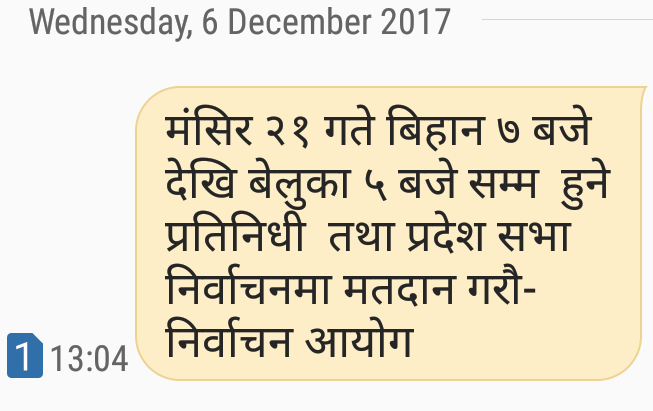 TV Programme – 'Nirwachan Sarokar' program was broadcasted from Nepal TV network and other TV networks during the election. Also, videos illustrating the condition when a vote was invalid, the time for voting, the way of staying in a queue at the polling station, were shown on Nepal TV network and other networks. Discussion programs on Election were also held through different TV networks.
TV Programme – 'Nirwachan Sarokar' program was broadcasted from Nepal TV network and other TV networks during the election. Also, videos illustrating the condition when a vote was invalid, the time for voting, the way of staying in a queue at the polling station, were shown on Nepal TV network and other networks. Discussion programs on Election were also held through different TV networks.
Sending message on mobile to cast vote: With the assistance of Nepal Telecom, the message like following was sent to citizens/voters on Election Day as well as the day before it. They were requested to go to own polling centre on time to use their voting right on Election Day. Candidates had also sent the message to the voters though mobile message to cast the votes to them.
ECN Mobile App launched: An ECN mobile app (Nepali & English) was launched for the first time to find voters, polling center, how to vote, candidate, and election result with media. More than 1 lakh people have downloaded this app.
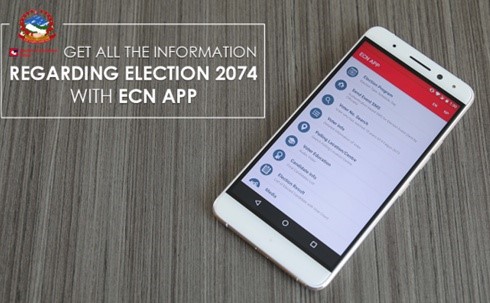
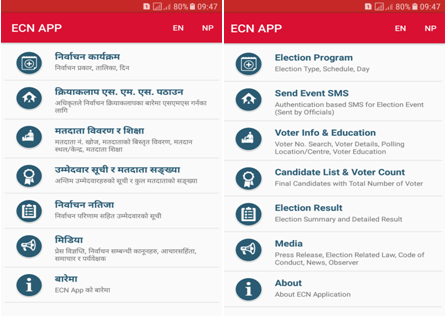 Observing digital content in EEIC: Voters and stakeholders were brought in Electoral Education Information Center (EEIC) of ECN to show the digital content describing importance of election and how to vote etc.
Observing digital content in EEIC: Voters and stakeholders were brought in Electoral Education Information Center (EEIC) of ECN to show the digital content describing importance of election and how to vote etc.
Digital video/audio in CD/DVD: The videos/audios related to voter education such as when a vote is invalid, the time for voting, the way of staying in a queue at the polling station were put into CD/DVD and made them available to volunteers and participants so that they could go to voters and show them visually.
ECN Website: ECN website http://www.election.gov.np/election/np/ was updated regularly to inform voters and stakeholders about elections. Mainly Press release, News, Electoral law, Election program schedule, Different activities like Voting Day, ID distribution Day, Nomination day etc. of election were put on the website. Final candidate list and Result were also published on separate website i.e. result.election.gov.np and the pages were accessed by more than 1.5 million people.
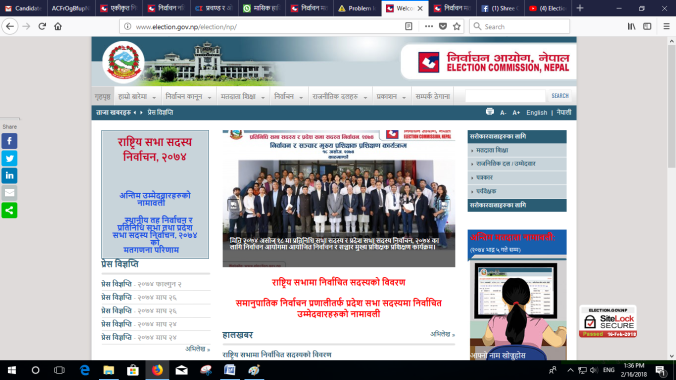
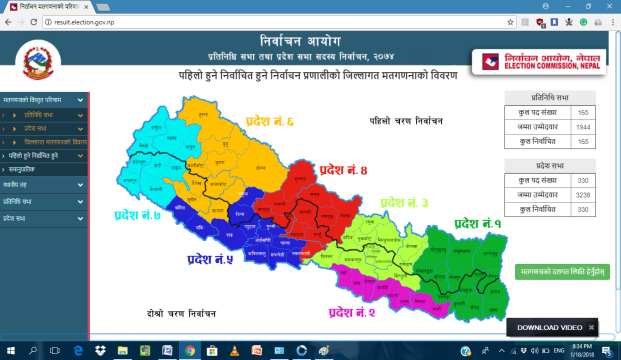 Government other agency website: Government's other agencies like Office of the Prime Minister and Council of Ministers and Ministry of Home Affairs had also played important role for voter education. They also updated their website and kept Election related information on it.
Government other agency website: Government's other agencies like Office of the Prime Minister and Council of Ministers and Ministry of Home Affairs had also played important role for voter education. They also updated their website and kept Election related information on it.
Online portals (News media and others): ECN had given permission to many private owned Online Portals to publish potential information regarding election.
Social media are computer-mediated technologies that facilitate the creation and sharing of information, ideas, career interests and other forms of expression via virtual communities and networks. Voter education was conducted through social media as follows: Facebook: ECN has own Facebook account https://www.facebook.com/ecnofficial. A number of photos, videos, music and information mentioning about different tiers of elections were shared through it. A social media campaign: I have voted and U? was initiated on the Facebook. Facebook also published reminder regarding Election Day and requested to cast vote by going to respective polling centre. Voters and stakeholders made query/complain on Facebook during election. A webmaster had replied them immediately.
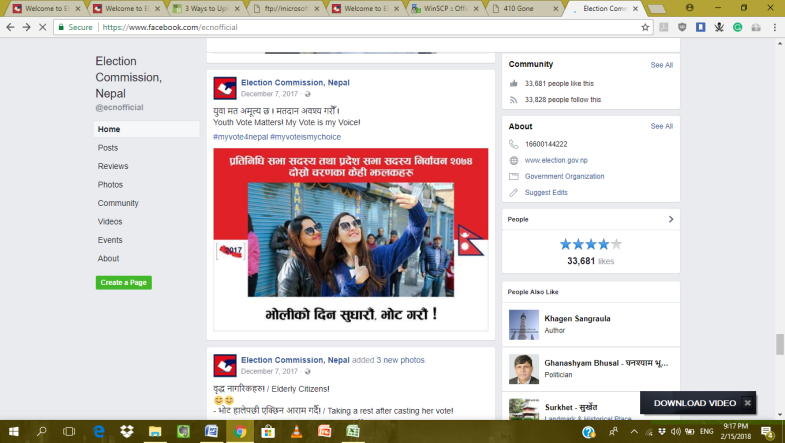
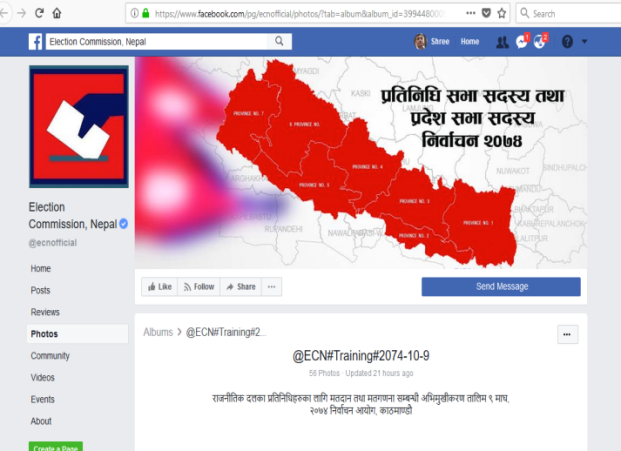 Twitter: ECN has twitter account www.twitter.com/ec_nepal. Election related information was also shared through it during election.
Twitter: ECN has twitter account www.twitter.com/ec_nepal. Election related information was also shared through it during election.
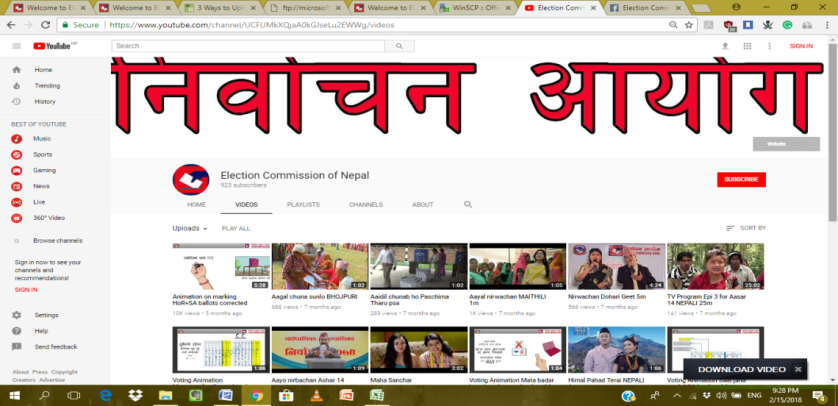 YouTube: The YouTube address of ECN is https://www.youtube.com/channel/UCFUMkXQjaA0kGJseLu2EWWg/videos. A number of videos related to local level election, house of representative and provincial level election were uploaded into YouTube to educate voters. Videos and music were done in different languages like Nepali, Maithili, Bhojpuri, Tharu etc. Two videos: one "Chunav ko Chaso/Concern of Election" used for local level election and second used for House of Representation and Provincial Assembly election were mentioned in following pages.
YouTube: The YouTube address of ECN is https://www.youtube.com/channel/UCFUMkXQjaA0kGJseLu2EWWg/videos. A number of videos related to local level election, house of representative and provincial level election were uploaded into YouTube to educate voters. Videos and music were done in different languages like Nepali, Maithili, Bhojpuri, Tharu etc. Two videos: one "Chunav ko Chaso/Concern of Election" used for local level election and second used for House of Representation and Provincial Assembly election were mentioned in following pages.
In addition to ECN, all the major parties and leaders were seen increasing their presence on social media during elections. They turned to social and digital media to reach to voters easily on large scale. It was also cost-effective, environment-friendly and efficient for interacting with voters. Nearly all parties, irrespective of their size, boasted official accounts on Facebook and Twitter, with a dedicated team to use them. The teams did multiple jobs, from monitoring cyberspace, promoting party/candidates, election agendas and increasing their reach.
Voters had enthusiastically participated in all three tiers of elections. Election Commission of Nepal in addition to online portals and Political parties/candidates used successfully digital and social media to conduct voter education in all tiers of election. However, there is the negative impact of digital and social media. Due to lack of cyber activists, it is difficult to trust fully on it. Proper utilization of digital and social media for voter education cuts off different unhidden costs of election and helps political parties/candidates to reach larger voters and stakeholders easily with less time. It is however, realized that voter education should be carried out very carefully by electoral authority. To do this effectively, reaching out to disadvantaged groups as well as mainstream voters is the foremost important thing. Voter education through digital and social media really cuts barriers and help reach the common voters with low cost, labor and time which naturally boosts democracy.
Chunav ko Chaso/Concern of Election This is a tele-drama named "Chunav ko Chaso/Concern of Election" shot by Officials of Election Commission of Nepal. This drama is uploaded into https://www.youtube.com/watch?v=Q2o2_FD8q1M&feature=share.
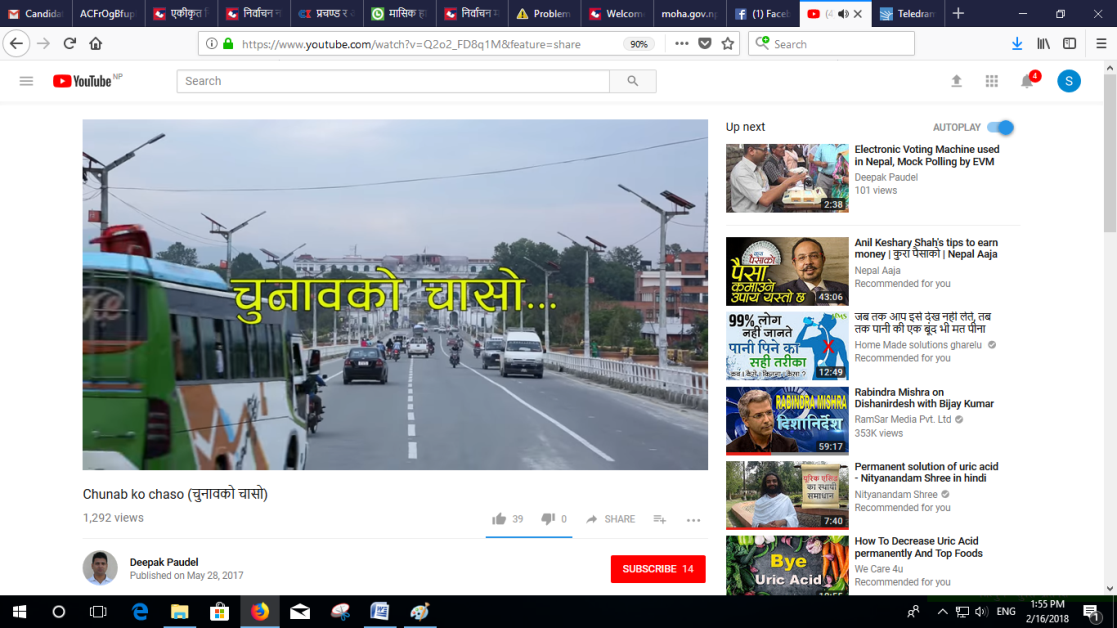 Three ordinary people who have visited in Asan Market, Kathmandu are discussing to go to their home town for the upcoming local level election. Suddenly they see one of their village mates on the road who has come to Kathmandu for searching a job. They are amused to see own village mates coming to the capital during election while others are trying to go home as fast as they can. They raise the question," why do you come here knowing there will be election very soon?" He replies that he didn't care about the election because of no trust on any of the candidates. Because all this time there have only been promises instead of action. One of the guy's uncles wants to be a candidate in the upcoming election whereas on other hand there is a woman who serves the society whole day night from a long time. Being young and enthusiastic, she deserves to be the proper candidate but the welfare of people matters the less.
Three ordinary people who have visited in Asan Market, Kathmandu are discussing to go to their home town for the upcoming local level election. Suddenly they see one of their village mates on the road who has come to Kathmandu for searching a job. They are amused to see own village mates coming to the capital during election while others are trying to go home as fast as they can. They raise the question," why do you come here knowing there will be election very soon?" He replies that he didn't care about the election because of no trust on any of the candidates. Because all this time there have only been promises instead of action. One of the guy's uncles wants to be a candidate in the upcoming election whereas on other hand there is a woman who serves the society whole day night from a long time. Being young and enthusiastic, she deserves to be the proper candidate but the welfare of people matters the less.
At one hand, they all want to be a part of election but on the contrary they know nothing about the election. Like, how should they vote? Or what a ballot paper looks like? They have visited nearby a café to take tea as well as to discuss about the election. To find the answers to some of these important questions they decide to go to the head office i.e. office of Election Commission, which is just near the market. They go to Information System Management Section of ECN to know about the concerned officer. The chief of this section told them to visit election operational section. They then went that section and met the chief of election operational section. They interacted with him to know about the ballot paper and procedure of the election. They get to know that the ballot paper for the election is bigger than they expected. But they soon get to know why they are big. For every district, the ballot papers are different. Like in some districts there may be many candidates from independent as well as from parties whereas for some districts there are fewer candidates. So, on the basis of candidates the ballot paper is decided as for more candidates more election sign is required.
There are six types of ballot paper- 18, 22, 28, 36, 44 and 68 small blocks consisting ballot paper. And the ballot paper over twenty eight is then divided into two columns. And the serial number is written too on top of the head. The big ballot papers are divided into two columns though they are the same ballot paper otherwise it will be long. So, all the things are identical between two columns. If you want to vote for chairman you can vote them at ballot number one in either of the columns on any of the desired election sign. Similarly, for vice-chairman you can allocate at number two and so on. In sixth column, one can vote for two candidates and the sixth column is divided by a huge dark border. These are some basic concepts to elect for the desired candidates during election. But these are not widely known by commoners which is the high reason for invalid ballot papers. After appreciated him for his valuable time, they finally decided to go to own village to teach villagers correct ways of voting in election.
HoR & PA related Video: This is informational video and can be found https://www.youtube.com/watch?v=2To0eNKwRHA. This is describing about HoR and PA elections with different types of ballot papers used for FPTP and PR. It also gives information how to vote and how to put a ballot paper into a box after voting. It also informs about the criteria that make votes valid and invalid
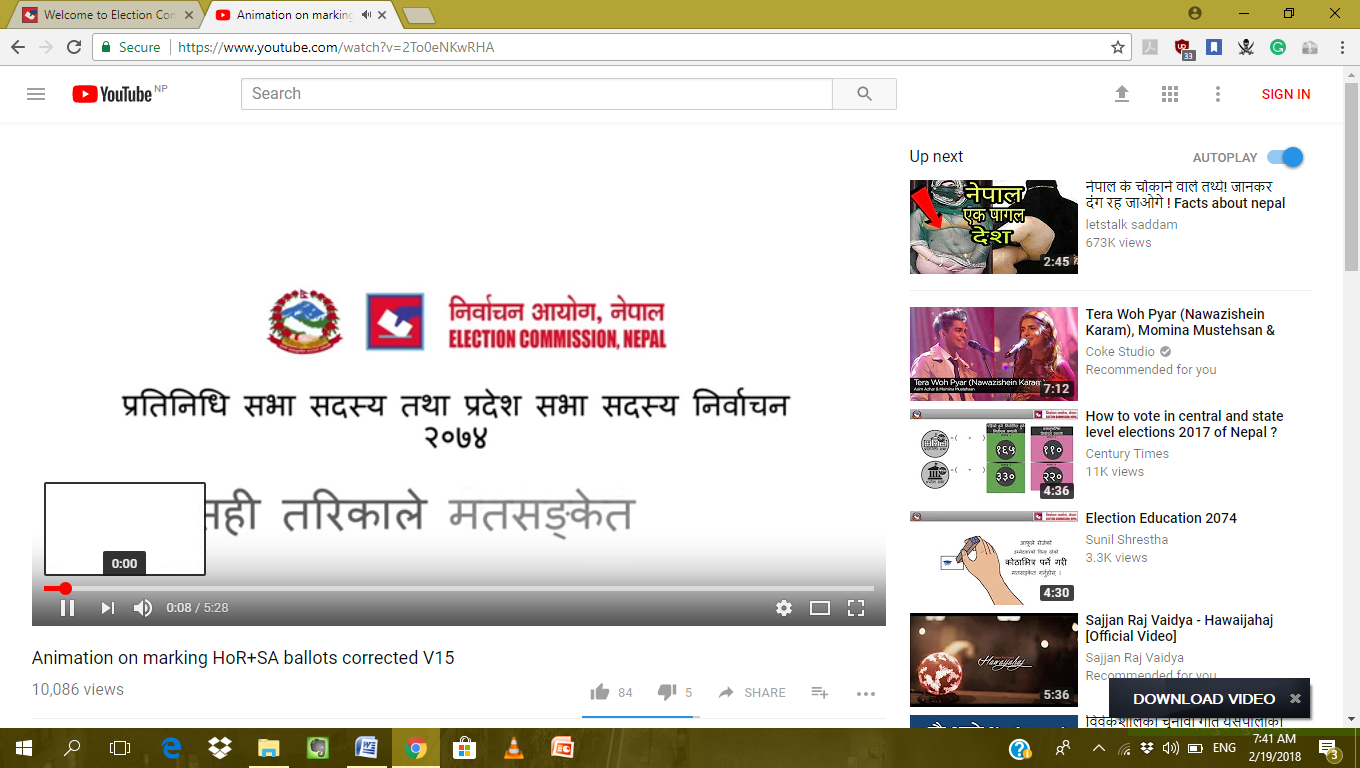
There are different ways to educate voters depending on time and technology advancement. Voter education was previously done with pamphlets, posters and wall painting; gradually changed to radio, television and newspapers and now-a-days digital and social media. Electoral authority has also taken major steps to reduce the use of pamphlets, posters and wall painting because it distorts the beauty of city/village. Digital and social media are becoming strong communication tools after availability of Internet to reach voters and stakeholder at large scale with minimum cost, labor and time.
The Constitution of Nepal declared Nepal as a federal democratic republican state with three levels of government: federal, provincial and local. After promulgation of new Constitution by Constituent Assembly dated Asoj 3, 2072 (Sep. 20, 2015), all three tiers of elections namely local level, provincial level and federal level elections are to be conducted before Magh 7, 2074 (Jan. 21, 2018). ECN as per mandate given by Constitution of Nepal has successfully conducted all three tiers of election scheduled on different dates of year 2074 (B.S.) with a great effort before the due date. This is an historic achievement in the history of ECN. Because this was the first time in the history of Nepal that so many elections were held in the same year 2074. So, the year 2074 is also remembered as Election Year.
The local level election was held at three phases dated Baisakh 31, 2074 (14 May 2017), Asar 14, 2074 (June 28, 2014) and Asoj 2, 2074(Sep 18, 2017). There were about 14.1 million voters for local level election out of which about 68% voters had casted their votes. Similarly, federal and provincial elections were held at two phases dated Mangsir 10, 2074 (November 26, 2017) and Mansir 21, 2074 (December 07, 2017). There were about 15.4 million voters for federal and provincial elections out of which about 69% voters had casted their votes and 2,056 voters for National Assembly Election (NAE) held on Magh 24, 2074 (Feb 07, 2018) out of which 99.52 % voters had casted their votes.
Voter education was really very challenging for ECN since different tiers of election should be done within a very short span of time. Also, all required legal documents were not prepared at the time of election declared date. Each election was of different type and hence consisted of different types of ballot papers, different vote casting and calculation method to select required members. Six types of ballot papers were fitted into one ballot paper of different size for local level election where voters had to cast seven votes for six posts like one Mayor/Chairman, one Deputy Mayor/Chairman, one Ward Chairperson, one Dalit Member, one Women Member and two Members. Three types of the ballot paper were designed for House of Representative (HoR) and Provincial Assembly (PA) elections where voters had to cast four votes for four members: one vote for first past the post (FPTP) of HoR and second vote for proportional representation (PR) for HoR, third vote for FPTP of PA election and fourth vote for PR of PAE. FPTP was based on majority system where as PR was based on cluster as well as party vote received. Lastly, there were four types of ballot papers for National Assembly (NA) Election where voters had to write priority 1, 2 and 3 on each type of ballot papers of Women and Others group; put a right sign against a candidate on each ballot paper of Dalit and Disability or Minority group. NA election was based on both majority and Single Transfer voting (STV) systems.
As mentioned above voter education was really complex and challenging during different tiers of election for election commission of Nepal keeping time-constraint, heterogeneous geographic location and climate. So, ECN had adopted different methodology to educate potential voters and stakeholder. Increase of use of computer in 21st century and availability of Internet enabled ECN to conduct voter education through digital and social media also in addition to using radio and print. Civil society organisations like NGO and INGO and political parties had also conducted voter education using digital and social media.
Digital media is digitized content that can be transmitted over the internet or computer networks. With use of digital media, voter education was conducted as follows:
 TV Programme – 'Nirwachan Sarokar' program was broadcasted from Nepal TV network and other TV networks during the election. Also, videos illustrating the condition when a vote was invalid, the time for voting, the way of staying in a queue at the polling station, were shown on Nepal TV network and other networks. Discussion programs on Election were also held through different TV networks.
TV Programme – 'Nirwachan Sarokar' program was broadcasted from Nepal TV network and other TV networks during the election. Also, videos illustrating the condition when a vote was invalid, the time for voting, the way of staying in a queue at the polling station, were shown on Nepal TV network and other networks. Discussion programs on Election were also held through different TV networks. Sending message on mobile to cast vote: With the assistance of Nepal Telecom, the message like following was sent to citizens/voters on Election Day as well as the day before it. They were requested to go to own polling centre on time to use their voting right on Election Day. Candidates had also sent the message to the voters though mobile message to cast the votes to them.
ECN Mobile App launched: An ECN mobile app (Nepali & English) was launched for the first time to find voters, polling center, how to vote, candidate, and election result with media. More than 1 lakh people have downloaded this app.


Digital video/audio in CD/DVD: The videos/audios related to voter education such as when a vote is invalid, the time for voting, the way of staying in a queue at the polling station were put into CD/DVD and made them available to volunteers and participants so that they could go to voters and show them visually.
ECN Website: ECN website http://www.election.gov.np/election/np/ was updated regularly to inform voters and stakeholders about elections. Mainly Press release, News, Electoral law, Election program schedule, Different activities like Voting Day, ID distribution Day, Nomination day etc. of election were put on the website. Final candidate list and Result were also published on separate website i.e. result.election.gov.np and the pages were accessed by more than 1.5 million people.


Online portals (News media and others): ECN had given permission to many private owned Online Portals to publish potential information regarding election.
Social media are computer-mediated technologies that facilitate the creation and sharing of information, ideas, career interests and other forms of expression via virtual communities and networks. Voter education was conducted through social media as follows: Facebook: ECN has own Facebook account https://www.facebook.com/ecnofficial. A number of photos, videos, music and information mentioning about different tiers of elections were shared through it. A social media campaign: I have voted and U? was initiated on the Facebook. Facebook also published reminder regarding Election Day and requested to cast vote by going to respective polling centre. Voters and stakeholders made query/complain on Facebook during election. A webmaster had replied them immediately.


 YouTube: The YouTube address of ECN is https://www.youtube.com/channel/UCFUMkXQjaA0kGJseLu2EWWg/videos. A number of videos related to local level election, house of representative and provincial level election were uploaded into YouTube to educate voters. Videos and music were done in different languages like Nepali, Maithili, Bhojpuri, Tharu etc. Two videos: one "Chunav ko Chaso/Concern of Election" used for local level election and second used for House of Representation and Provincial Assembly election were mentioned in following pages.
YouTube: The YouTube address of ECN is https://www.youtube.com/channel/UCFUMkXQjaA0kGJseLu2EWWg/videos. A number of videos related to local level election, house of representative and provincial level election were uploaded into YouTube to educate voters. Videos and music were done in different languages like Nepali, Maithili, Bhojpuri, Tharu etc. Two videos: one "Chunav ko Chaso/Concern of Election" used for local level election and second used for House of Representation and Provincial Assembly election were mentioned in following pages.In addition to ECN, all the major parties and leaders were seen increasing their presence on social media during elections. They turned to social and digital media to reach to voters easily on large scale. It was also cost-effective, environment-friendly and efficient for interacting with voters. Nearly all parties, irrespective of their size, boasted official accounts on Facebook and Twitter, with a dedicated team to use them. The teams did multiple jobs, from monitoring cyberspace, promoting party/candidates, election agendas and increasing their reach.
Voters had enthusiastically participated in all three tiers of elections. Election Commission of Nepal in addition to online portals and Political parties/candidates used successfully digital and social media to conduct voter education in all tiers of election. However, there is the negative impact of digital and social media. Due to lack of cyber activists, it is difficult to trust fully on it. Proper utilization of digital and social media for voter education cuts off different unhidden costs of election and helps political parties/candidates to reach larger voters and stakeholders easily with less time. It is however, realized that voter education should be carried out very carefully by electoral authority. To do this effectively, reaching out to disadvantaged groups as well as mainstream voters is the foremost important thing. Voter education through digital and social media really cuts barriers and help reach the common voters with low cost, labor and time which naturally boosts democracy.
Chunav ko Chaso/Concern of Election This is a tele-drama named "Chunav ko Chaso/Concern of Election" shot by Officials of Election Commission of Nepal. This drama is uploaded into https://www.youtube.com/watch?v=Q2o2_FD8q1M&feature=share.

At one hand, they all want to be a part of election but on the contrary they know nothing about the election. Like, how should they vote? Or what a ballot paper looks like? They have visited nearby a café to take tea as well as to discuss about the election. To find the answers to some of these important questions they decide to go to the head office i.e. office of Election Commission, which is just near the market. They go to Information System Management Section of ECN to know about the concerned officer. The chief of this section told them to visit election operational section. They then went that section and met the chief of election operational section. They interacted with him to know about the ballot paper and procedure of the election. They get to know that the ballot paper for the election is bigger than they expected. But they soon get to know why they are big. For every district, the ballot papers are different. Like in some districts there may be many candidates from independent as well as from parties whereas for some districts there are fewer candidates. So, on the basis of candidates the ballot paper is decided as for more candidates more election sign is required.
There are six types of ballot paper- 18, 22, 28, 36, 44 and 68 small blocks consisting ballot paper. And the ballot paper over twenty eight is then divided into two columns. And the serial number is written too on top of the head. The big ballot papers are divided into two columns though they are the same ballot paper otherwise it will be long. So, all the things are identical between two columns. If you want to vote for chairman you can vote them at ballot number one in either of the columns on any of the desired election sign. Similarly, for vice-chairman you can allocate at number two and so on. In sixth column, one can vote for two candidates and the sixth column is divided by a huge dark border. These are some basic concepts to elect for the desired candidates during election. But these are not widely known by commoners which is the high reason for invalid ballot papers. After appreciated him for his valuable time, they finally decided to go to own village to teach villagers correct ways of voting in election.
HoR & PA related Video: This is informational video and can be found https://www.youtube.com/watch?v=2To0eNKwRHA. This is describing about HoR and PA elections with different types of ballot papers used for FPTP and PR. It also gives information how to vote and how to put a ballot paper into a box after voting. It also informs about the criteria that make votes valid and invalid

Shree Chandra Sah
Senior Computer Officer (Gaz. 2nd Class), ECN